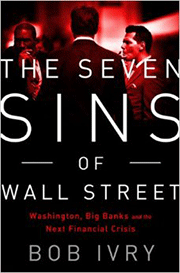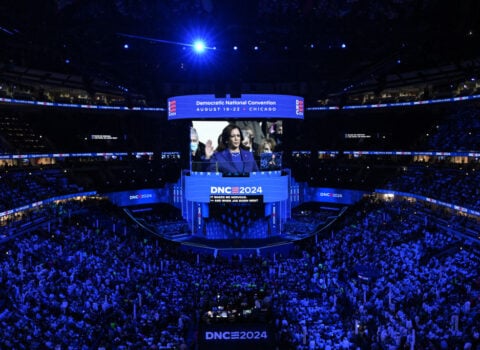Sins of the Fatcat
Back in February, Congressman David Camp (R., Mich.), chairman of the tax-writing House Ways and Means Committee, unveiled a plan to reform the U.S. tax code, clarifying and simplifying its infinite and tortuous provisions. One of his proposals was to levy a tax of .035 percent on assets exceeding $500 billion held by U.S. megabanks and insurance companies. This, he explained, would offset the advantage big banks enjoy in borrowing costs thanks to their implicit government-bailout guarantee as too-big-to-fail institutions.
It was a laudable enough idea, in a modest kind of way. Coming from a House Republican it certainly had the merit of novelty. But no one among the massed ranks of financial-industry hirelings on K Street and Capitol Hill took it seriously enough to plan a vigorous counterattack. Camp is due to step down from his chairmanship soon, and everyone in Washington is well aware of the banks’ invulnerability to attempts at prizing away even a sliver of their hoards. “Dead on arrival” was the common verdict.
That wasn’t the way JPMorgan Chase CEO Jamie Dimon, Wall Street’s capo di tutti frutti, saw things, though. “He was calling everyone, from the Speaker on down,” one lobbyist reported to me in amazement. “He was frantic about the threat of Camp, as if anything was ever going to come out of that.”
The only interpretation the D.C. financial lobbying community could make of Dimon’s hysterical behavior was that they had done their work too well. “The banks have gotten absolutely everything they wanted, post-crash,” my lobbyist friend explained. The 2010 SAFE bill, through which Senators Sherrod Brown and Ted Kaufman attempted to break up the too-big-to-fails? Crushed like a bug in the Senate, 60–31. The Volcker Rule restricting banks from trading on their own account? Riddled with more loopholes than a yard of chicken wire. The Lincoln Amendment barring institutions from gambling with taxpayer-insured money? On its way out the door. “There really are no outstanding issues left for them to fight over,” my friend said, “so now even the semblance of defiance from any quarter is taken as a personal affront, and they move to crush it.”
Nevertheless, in obeisance to Dimon’s fevered response, lobbyists are armoring up for an all-out offensive. In the fighting words of Cam Fine, chief of the Community Bankers Association of America: “We’re going to beat this like a rented mule.”
In a vague sort of way, most people are aware that Wall Street crashed the economy and rode out of town scot-free, collecting unimaginably huge bonuses along the way. But vagueness breeds passivity. Fortunately, we now have Bob Ivry’s Seven Sins of Wall Street (Public Affairs) as an indispensable guide for tracking down live villains and unburied bodies. By the time you reach the end, all the sheer fury anyone with the merest flutter of a moral pulse felt back in 2008 and 2009 at the sight of bankers and their apologists blaming the cratering of the global economy on “people buying houses they couldn’t afford” wells up again, white hot.
There are by now shelves full of histories of the bubble era, some of which even manage to be kind and understanding about the Gucci-clad perps who blew it up. (I’m thinking of Andrew Ross-Sorkin’s Too Big to Fail, in particular.) Ivry’s contribution is to explain in limpid prose just what they have been up to since the third week of September 2008, when, as he reports, “more than one high-placed man in American finance made a phone call to his wife, telling her to go to the ATM and withdraw as much cash as she could, because it looked like the ATMs might run dry.”
It’s not a pretty picture. Among the victims Ivry describes is Rebecca Black, a nurse in Memphis who lost her “dream house” to foreclosure in 2010 when she could no longer afford the upwardly adjusting rate of her usurious 2/28 mortgage (low interest for two years, remorselessly increasing thereafter). But EMC Mortgage, the JPMorgan subsidiary that owned the note, never actually took possession, so she was still liable for the property tax, plus the $520 the city charged her for boarding up her by-then-snake-infested house and mowing her lawn. Meanwhile, the total assets of JPMorgan, whose overnight borrowing from the Federal Reserve peaked on October 1, 2008, at $68.6 billion, have shot up 78 percent to $2.39 trillion since the crash. As Ivry writes, “The grass keeps growing and the snakes have come back.”
Just to take one snake in particular, let’s look at Citigroup. Sired by Sandy Weill and Jamie Dimon out of Commercial Credit, a Baltimore loansharking operation they bought in 1986 that offered credit at 40 percent interest to semiliterate Mississippi farmers, Citi is the behemoth that needed $99.5 billion from the Fed in a hurry on January 20, 2009. Even President Barack Obama thought it should be broken up and sold off, until National Economic Council director Larry Summers and Treasury Secretary Timothy Geithner stomped on the idea. Instead, Citigroup carried straight on doing what came naturally: buying up fraudulent mortgages and selling them on.
Before 2008, many of their customers had been private investors, but that market vaporized in the crash. So, as Ivry pithily explains, Wall Street opted for a comfortable and profitable life on public welfare: “In the months and years after the financial crisis, the top people in Wall Street and Washington had engineered a closed loop that ensured their feet never touched the dirty ground. Wall Street would originate the mortgages, and Washington would buy them. (The government was involved in nine out of ten home loans in 2013.) The Treasury would sell debt, and Wall Street would buy it, then sell it back to the Federal Reserve. (This was called ‘quantitative easing.’)”
Naturally, fraud was involved, certainly in the case of Citigroup and its mortgage-buying subsidiary CitiMortgage. We know this, as Ivry explains, because a public-spirited CitiMortgage executive, Sherry Hunt, thought there was something wrong with the shady mortgages whose purchase she was forcefully encouraged to approve for later sale to the taxpayer, as represented by the Federal Housing Administration.
After her efforts to raise the matter internally went nowhere, Hunt brought her concerns to the attention of Preet Bharara, U.S. Attorney for the Southern District of New York. He, too, thought there was something wrong, and brought suit against Citi. The bank quickly caved and paid $158.3 million to settle the charges. So watertight was the case against it that the bank actually had to admit to having done something wrong. But that didn’t stop Sanjiv Das, Citigroup’s chief executive, from telling Ivry with a straight face that “the FHA was not defrauded.” Hearing this astonishing claim, Ivry recalls trying “to find the switch on my bullshit meter, which I had on vibrate and which was now rattling my molars.”
By the way, you and I didn’t know about that $99.5 billion tide-them-over loan at the time, because the Fed’s colossal Wall Street bailout — $1.2 trillion committed on a single day — was a closely held secret, not to be mentioned in front of the children, thus enabling such lucky recipients as Wells Fargo to claim with a straight face that they never needed or wanted a bailout, and to explain that they took $25 billion from the Troubled Asset Relief Program (TARP, the bailout we did hear about) only because the Treasury Secretary forced it down their throats. In fact, Wells Fargo asked for $45 billion on February 26, 2009, because they really needed it, in a hurry. And of course they got it, no questions asked.
 We know about these events now thanks to Ivry’s partner in crime at Bloomberg News, the late, great Mark Pittman, who conceived the idea of suing the Federal Reserve under the Freedom of Information Act. As Seven Sins recounts in chapter two (“Wrath”), the Fed and the Clearing House Association (a.k.a. Wall Street’s biggest banks) fought bitterly to keep the story of the crisis under wraps, citing the sanctity of “trade secrets.” Ultimately justice, buoyed by Bloomberg’s bounteous legal war chest, prevailed, and we got to learn how dirty some of those secrets were.
We know about these events now thanks to Ivry’s partner in crime at Bloomberg News, the late, great Mark Pittman, who conceived the idea of suing the Federal Reserve under the Freedom of Information Act. As Seven Sins recounts in chapter two (“Wrath”), the Fed and the Clearing House Association (a.k.a. Wall Street’s biggest banks) fought bitterly to keep the story of the crisis under wraps, citing the sanctity of “trade secrets.” Ultimately justice, buoyed by Bloomberg’s bounteous legal war chest, prevailed, and we got to learn how dirty some of those secrets were.
The sins go on and on, though Ivry hews to convention and stops at number seven, (“Greed”). Meanwhile Rebecca Black, the nurse who lost her Memphis home to the snakes, lives in a one-bedroom apartment and works an $11 per hour job. The company she works for is owned by JPMorgan Chase.






